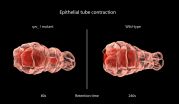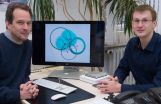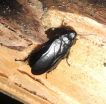A vegetarian carnivorous plant
2014-12-19
(Press-News.org) Carnivorous plants catch and digest tiny animals in order and derive benefits for their nutrition. Interestingly the trend towards vegetarianism seems to overcome carnivorous plants as well. The aquatic carnivorous bladderwort, which can be found in many lakes and ponds worldwide, does not only gain profit from eating little animals but also by consuming algae and pollen grains. This results in survival in aquatic habitats where prey animals are rare, and in increased fitness if the animals and algae are caught in a well-balanced diet. An Austrian research group around Marianne Koller-Peroutka and Wolfram Adlassnig published these results in the respected journal Annals of Botany.
The bladderworts (Utricularia) are one of the largest genera in carnivorous plants with over 200 species. Aquatic bladderworts catch their prey with highly sophisticated suction traps consisting of little bladders that produce a hydrostatic under pressure. A valve-like trap door opens upon stimulation and the surrounding water including tiny organism flushes in rapidly within three milliseconds. Once inside the trap, the prey dies of suffocation and is degraded by digestive enzymes. Due to the minerals provided by prey organisms, bladderworts are able to live and propagate even in habitats that are extremely poor in nutrients.
Animals are not the only prey
First observations on algae within the traps of bladderworts go back to 1900 but only now their role within the prey spectrum was analysed by a research team of the University of Vienna. Screening of the prey objects in more than 2,000 traps showed that only 10 % were animals whereas 50 % of the prey objects were algae. Especially in nutrient poor habitats like in peat bogs, algae were even more dominant in the prey. More than one third of the prey consisted of pollen grains from trees growing on the shore areas of the home waters. However Utricularia does not seem to select its menu; in fact, it sucks in everything small enough to enter the trap door.
A well balanced diet keeps the plant healthy!
Previously, algae and pollen had been considered as useless bycatch which was accidentally sucked in together with animal prey. However, data on trapped algae and the growth of the plant as well as the formation of hibernation buds leads to a completely new insight: Utricularia plants that had trapped successfully numerous algae and pollen grains were larger and formed more biomass. More animal prey, on the other hand, leads to a higher nitrogen-content of the plant and to increased formation of hibernation buds, which is of vital importance to survive the winter period. Plants with a well balanced diet of algae and pollen, as well as animal prey were in the best shape. Thus it can be concluded that Utricularia gains specific nutrients like nitrogen mainly from animal prey whereas other nutrients like micronutrients and trace elements were derived mainly from algae and pollen.
Traps suck in without triggering
Until recently, it was assumed that suction traps have to be triggered by movements of animal prey but new studies showed that aquatic bladders do require stimulation and "fire" even if they are not stimulated for a longer time. In the natural habitat, more than 50% of all bladders contained only immotile prey like algae, pollen bacteria and fungi but no animal prey that was capable to trigger and open the trap. Thus, prey capture without external stimulation is crucial for these plants.
Aquatic bladderworts are able to gain benefit by catching all kind of prey organisms. Only for this reason, Utricularia is able to survive and even propagate in habitats that are only sparsely populated by animals. Algae and pollen as well as animal prey differ in mineral nutrients as well as other compounds. A well balanced diet therefore provides a wider range of nutrients that can be utilised by this unique carnivorous plant.
INFORMATION:
ELSE PRESS RELEASES FROM THIS DATE:
2014-12-19
Researchers at the Mechanobiology Institute (MBI), National University of Singapore (NUS) have identified a novel mechanosensitive regulation of epithelial tube contraction. These findings are published on 19 December 2014 in Current Biology (Pei Yi Tan and Ronen Zaidel-Bar. Transient membrane localization of SPV-1 drives cyclical actomyosin contractions in the C. elegans spermatheca, Current Biology, 19 Dec 2014, doi: 10.1016/j.cub.2014.11.033)
Regulating tube constriction
Many of the fundamental processes of life rely on biological structures known as epithelial ...
2014-12-19
Over the past decade, ocean acidification has received growing recognition not only in the scientific area. Decision-makers, stakeholders, and the general public are becoming increasingly aware of "the other carbon dioxide problem". It is time to reflect on the successes and deficiencies of ocean acidification research and to take a look forward at the challenges the fastest growing field of marine science is facing. In the January issue of the journal Nature Climate Change Ulf Riebesell, professor for Biological Oceanography at GEOMAR Helmholtz Centre for Ocean Research ...
2014-12-19
Bremerhaven/Germany, 18 December 2014. Ingestion of microplastic particles does not mechanically affect marine isopods. This was the result of a study by biologists at the North Sea Office of the Alfred Wegener Institute, Helmholtz Centre for Polar and Marine Research (AWI) that was published recently in the journal Environmental Science and Technology. The study marks the launch of a series of investigations aimed at forming a risk matrix on the sensitivity of different marine species to microplastic pollution.
Uptake of large plastic items by birds and fish may cause ...
2014-12-19
In a recent study from Lund University in Sweden, researchers have used new technology to study extremely fast processes in solar cells. The research results form a concrete step towards more efficient solar cells.
The upper limit for the efficiency of normal solar cells is around 33 per cent. However, researchers now see a possibility to raise that limit to over 40 per cent, thereby significantly improving the potential of this energy source.
The experiments in the present study involved 'juggling' on quantum level with photons, i.e. light particles, and electrons. ...
2014-12-19
In everyday life, the global positioning system (GPS) can be employed to reliably determine the momentary location of one en route to the desired destination. Scientists from the Institute of Physical and Theoretical Chemistry of the University of Bonn have now developed a molecular "GPS" with which the whereabouts of metal ions in enzymes can be reliably determined. Such ions play important roles in all corners of metabolism and synthesis for biological products. The "molecular GPS" is now being featured in the journal Angewandte Chemie.
There would be no life on our ...
2014-12-19
Bethesda, MD (Dec. 19, 2014) -- A new formulation of oral budesonide suspension, a steroid-based treatment, is safe and effective in treating pediatric patients with eosinophilic esophagitis (EoE), according to a new study in Clinical Gastroenterology and Hepatology, the official clinical practice journal of the American Gastroenterological Association. Eosinophilic esophagitis is a chronic immune system disease caused by a buildup of white blood cells in the lining of the esophagus. This build up, which is a reaction to food, allergens or acid reflux, can inflame or injure ...
2014-12-19
The changes can be measured, but their reasons were unknown. For several decades, scientists have carefully observed that the oxygen minimum zones (OMZ) in the tropical oceans are expanding. These zones are a paradise for some specially adapted microorganisms, but for all larger marine organisms such as fish and marine mammals they are uninhabitable. Thus, their expansion has already narrowed down the habitat of some fish species.
Marine scientists from the GEOMAR Helmholtz Centre for Ocean Research Kiel and the Kiel Collaborative Research Centre (Sonderforschungsbereich, ...
2014-12-19
PITTSBURGH--University of Pittsburgh researchers have shared their findings from three studies related to shale gas in a recent special issue of the journal Energy Technology, edited by Götz Veser, the Nickolas A. DeCecco Professor of Chemical and Petroleum Engineering in Pitt's Swanson School of Engineering.
In the special issue focusing on shale gas, Pitt faculty authors look at "smart wells" that use wireless communication, wastewater management, and information gaps between legislators, regulators, industry representatives, researchers, and the public on the ...
2014-12-19
Scientists from the Southwest University, Chongqing, China have found a new species and a new subspecies of cockroach. What makes these creepy crawlies distinctive from the cockroaches most of us know is that they don't infest human houses, on the contrary they prefer to live a hermit life drilling logs, hidden away from human eyes. The study was published in the open access journal ZooKeys.
Out of around 4,600 species worldwide, only 30 are the cockroaches associated with human habitats that gives the bad fame of these creatures. The representatives of the genus Panesthia, ...
2014-12-19
Most parents are not surprised by the irregularity of a newborn infant's sleep patterns, but by six months or so many parents wonder if something is wrong with their baby or their sleeping arrangements if the baby is not sleeping through the night. Healthcare providers, specifically nurse practitioners, can help parents understand what "normal" sleep patterns are for their child, according to researchers.
"Nurse practitioners are at the frontline of healthcare," said Robin Yaure, senior instructor of human development and family studies, Penn State Mont Alto. "They are ...
LAST 30 PRESS RELEASES:
[Press-News.org] A vegetarian carnivorous plant


